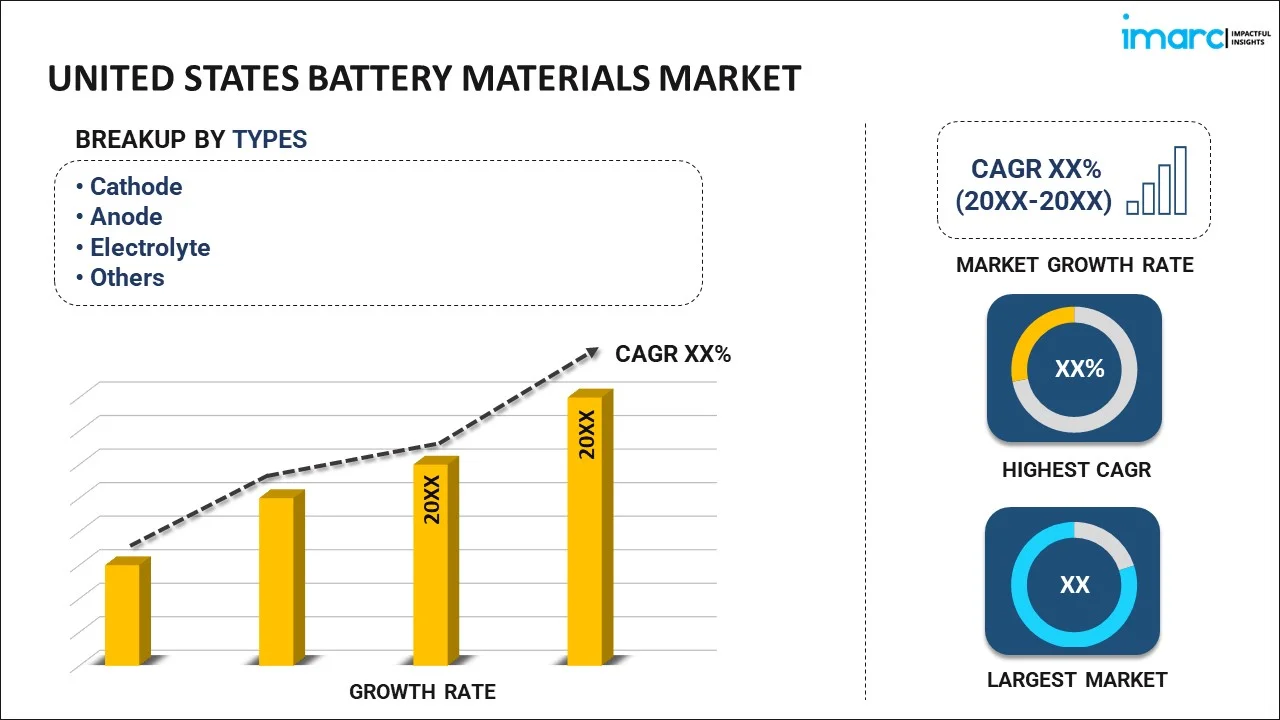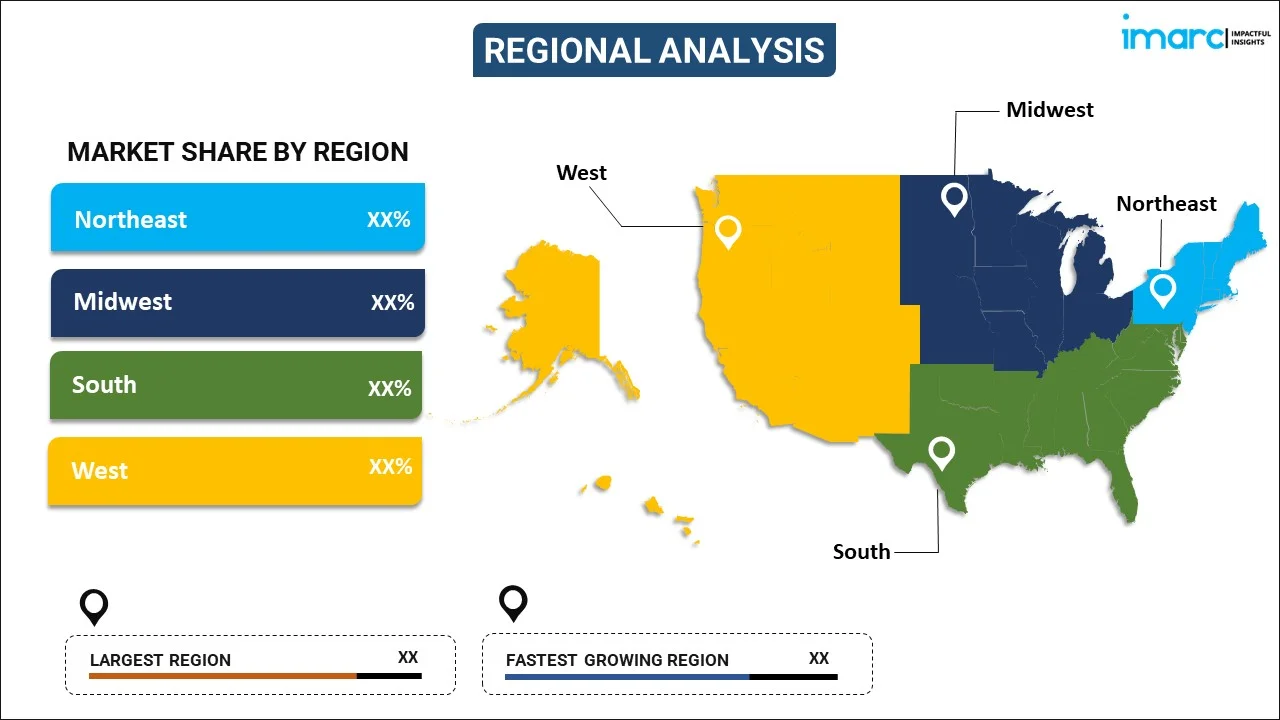
United States Battery Materials Market Report by Type (Cathode, Anode, Electrolyte, Separator, and Others), Battery Type (Lithium Ion, Lead Acid, and Others), Application (Automobile Industry, Household Appliances, Electronics Industry, and Others), and Region 2025-2033
Market Overview:
United States battery materials market size is projected to exhibit a growth rate (CAGR) of 7.79% during 2025-2033. The expanding healthcare sector, which relies heavily on primary batteries for various medical devices, such as pacemakers, insulin pumps, and hearing aids, is driving the market.
|
Report Attribute
|
Key Statistics
|
|---|---|
|
Base Year
|
2024 |
|
Forecast Years
|
2025-2033 |
|
Historical Years
|
2019-2024
|
| Market Growth Rate (2025-2033) | 7.79% |
Battery materials are essential components used in the construction of batteries, playing a crucial role in their overall performance. These materials vary depending on the type of battery, such as lithium-ion, nickel-metal hydride, or lead-acid batteries. Common materials include cathodes, anodes, electrolytes, and separators. Cathodes are typically composed of materials like lithium cobalt oxide or nickel manganese cobalt oxide, while anodes may consist of graphite or lithium titanate. Electrolytes, often made of lithium salts in a solvent, facilitate the flow of ions between the cathode and anode. Separators prevent direct contact between these electrodes, maintaining the battery's integrity. Advancements in battery materials research aim to enhance energy density, lifespan, and safety, contributing to the development of more efficient and sustainable energy storage solutions for diverse applications, from electric vehicles to portable electronics and renewable energy systems.
United States Battery Materials Market Trends:
The battery materials market in the United States is experiencing robust growth, driven by several key factors. Firstly, the escalating demand for electric vehicles (EVs) is a primary catalyst. As the automotive industry increasingly transitions towards sustainable practices, the need for high-performance batteries has surged, propelling the demand for advanced battery materials. Additionally, the regional emphasis on renewable energy sources has fueled the deployment of energy storage systems, further amplifying the demand for efficient battery technologies. Moreover, the continuous advancements in portable electronic devices contribute significantly to the expansion of the battery materials market. The perpetual evolution of smartphones, wearables, and other consumer electronics necessitates batteries with enhanced energy density and longer life cycles, stimulating the development and adoption of innovative materials in battery manufacturing. Furthermore, the increasing awareness and initiatives towards environmental sustainability that are influencing both consumers and industries to invest in clean energy solutions are expected to drive the battery materials market in the United States during the forecast period.
United States Battery Materials Market Segmentation:
IMARC Group provides an analysis of the key trends in each segment of the market, along with forecasts at the country level for 2025-2033. Our report has categorized the market based on type, battery type, and application.
Type Insights:

- Cathode
- Anode
- Electrolyte
- Separator
- Others
The report has provided a detailed breakup and analysis of the market based on the type. This includes cathode, anode, electrolyte, separator, and others.
Battery Type Insights:
- Lithium Ion
- Lead Acid
- Others
A detailed breakup and analysis of the market based on the battery type have also been provided in the report. This includes lithium ion, lead acid, and others.
Application Insights:
- Automobile Industry
- Household Appliances
- Electronics Industry
- Others
The report has provided a detailed breakup and analysis of the market based on the application. This includes automobile industry, household appliances, electronics industry, and others.
Regional Insights:

- Northeast
- Midwest
- South
- West
The report has also provided a comprehensive analysis of all the major regional markets, which include the Northeast, Midwest, South, and West.
Competitive Landscape:
The market research report has also provided a comprehensive analysis of the competitive landscape in the market. Competitive analysis such as market structure, key player positioning, top winning strategies, competitive dashboard, and company evaluation quadrant has been covered in the report. Also, detailed profiles of all major companies have been provided.
United States Battery Materials Market Report Coverage:
| Report Features | Details |
|---|---|
| Base Year of the Analysis | 2024 |
| Historical Period | 2019-2024 |
| Forecast Period | 2025-2033 |
| Units | Million USD |
| Scope of the Report | Exploration of Historical Trends and Market Outlook, Industry Catalysts and Challenges, Segment-Wise Historical and Future Market Assessment:
|
| Types Covered | Cathode, Anode, Electrolyte, Separator, Others |
| Battery Types Covered | Lithium Ion, Lead Acid, Others |
| Applications Covered | Automobile Industry, Household Appliances, Electronics Industry, Others |
| Regions Covered | Northeast, Midwest, South, West |
| Customization Scope | 10% Free Customization |
| Post-Sale Analyst Support | 10-12 Weeks |
| Delivery Format | PDF and Excel through Email (We can also provide the editable version of the report in PPT/Word format on special request) |
Key Questions Answered in This Report:
- How has the United States battery materials market performed so far and how will it perform in the coming years?
- What has been the impact of COVID-19 on the United States battery materials market?
- What is the breakup of the United States battery materials market on the basis of type?
- What is the breakup of the United States battery materials market on the basis of battery type?
- What is the breakup of the United States battery materials market on the basis of application?
- What are the various stages in the value chain of the United States battery materials market?
- What are the key driving factors and challenges in the United States battery materials?
- What is the structure of the United States battery materials market and who are the key players?
- What is the degree of competition in the United States battery materials market?
Key Benefits for Stakeholders:
- IMARC’s industry report offers a comprehensive quantitative analysis of various market segments, historical and current market trends, market forecasts, and dynamics of the United States battery materials market from 2019-2033.
- The research report provides the latest information on the market drivers, challenges, and opportunities in the United States battery materials market.
- Porter's five forces analysis assist stakeholders in assessing the impact of new entrants, competitive rivalry, supplier power, buyer power, and the threat of substitution. It helps stakeholders to analyze the level of competition within the United States battery materials industry and its attractiveness.
- A competitive landscape allows stakeholders to understand their competitive environment and provides an insight into the current positions of key players in the market.
Need more help?
- Speak to our experienced analysts for insights on the current market scenarios.
- Include additional segments and countries to customize the report as per your requirement.
- Gain an unparalleled competitive advantage in your domain by understanding how to utilize the report and positively impacting your operations and revenue.
- For further assistance, please connect with our analysts.
 Inquire Before Buying
Inquire Before Buying
 Speak to an Analyst
Speak to an Analyst
 Request Brochure
Request Brochure
 Request Customization
Request Customization




.webp)




.webp)












